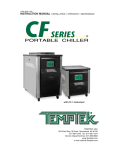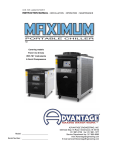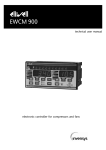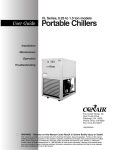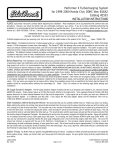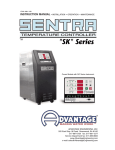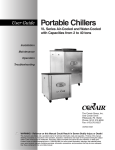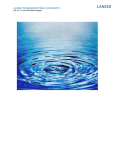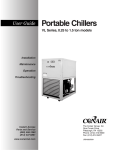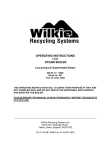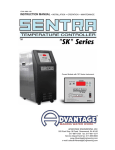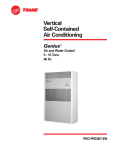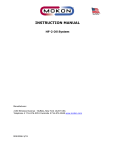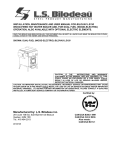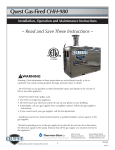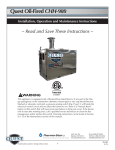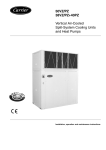Download Portable Chiller Service Manual
Transcript
I.O.M. #085 8/06 INSTRUCTION MANUAL • INSTALLATION • OPERATION • MAINTENANCE Water-Cooled and Air-Cooled with CF-1 Instrument TEMPTEK, INC. 525 East Stop 18 Road Greenwood, IN 46142 317-887-0729 fax: 317-881-1277 Service Department fax: 317-885-8683 www.Temptek.com e-mail: [email protected] INSTRUCTION MANUAL CF Series Portable Chiller 2 - 4 Tons Air-Cooled & Water-Cooled COVERING INSTALLATION OPERATION MAINTENANCE TEMPTEK, INC. 525 East Stop 18 Road Greenwood, IN 46142 317-887-0729 fax: 317-881-1277 Service Department fax: 317-885-8683 www.TempTek.com e-mail: [email protected] CF Series Portable Chillers with CF-1 Instrument TABLE OF CONTENTS 1.0 GENERAL 1.1 Introduction 1.2 Unit location for air cooled models 1.3 Unit location for water cooled models 1.4 Efficiency 1.5 Safety 1.6 Clean air act 1.7 Miscellaneous 7 8 8 8 8 9 9 9 2.0 INSTALLATION 2.1 General 2.2 To and From process connections 2.3 Water supply connection 2.4 Air cooled condenser 2.5 Electrical connection 11 12 12 13 13 14 3.0 OPERATIONS 3.1 General 3.2 Start up/operations procedure 3.3 Instrument/operation 3.4 Shut down procedure 17 18 19 24 31 4.0 TROUBLESHOOTING 4.1 Sensors 4.2 Process/evaporator pump 4.3 Compressor 4.4 Low flow 4.5 Blower/fan 4.6 High pressure 4.7 Low pressure 4.8 Water level 4.9 Freezestat 4.10 Crankcase heater 4.11 Chiller controller 31 32 32 32 32 32 33 33 33 34 34 34 5.0 MAINTENANCE 5.1 Warranty service procedure 5.2 Periodic preventative maintenance 5.3 Special maintenance 5.4 Solenoid valve service 5.5 Pump seal service 5.6 Checking the refrigerant charge 5.7 Proper cleaning procedure for brazed plate evaporators 5.8 DIP switch adjustment 35 36 36 37 38 40 43 43 45 TEMPTEK, INC. 525 East Stop 18 Road Greenwood, Indiana 46142 317-887-6352 Fax: 317-881-1277 Service Department Fax: 317-885-8683 Website: www.Temptek.com Email: [email protected] Page: 4 CF Series Portable Chillers with CF-1 Instrument 6.0 COMPONENTS 6.1 Water system 6.2 Refrigeration system 47 48 48 7.0 RELATED DRAWINGS 7.1 Mechanical schematic : air-cooled 7.2 Mechanical schematic : water-cooled 51 52 53 8.0 APPENDIX 8.1 Specifications 8.2 Operations below 48°F 8.3 Water quality control 8.4 Inhibited propylene glycol 8.5 Sensor current vs temperature 8.6 Refrigerant pressure-temperature chart 8.7 Chiller capacity and derate chart 55 56 57 58 58 59 60 61 TEMPTEK, INC. 525 East Stop 18 Road Greenwood, Indiana 46142 317-887-6352 Fax: 317-881-1277 Service Department Fax: 317-885-8683 Website: www.Temptek.com Email: [email protected] Page: 5 THIS PAGE INTENTIONALLY BLANK Page: 6 CF Series Portable Chillers with CF-1 Instrument 1.0 GENERAL 1.1 1.2 1.3 1.4 1.5 UNIT LOCATION EFFICIENCY SAFETY CLEAN AIR ACT MISCELLANEOUS TEMPTEK, INC. 525 East Stop 18 Road Greenwood, Indiana 46142 317-887-6352 Fax: 317-881-1277 Service Department Fax: 317-885-8683 Website: www.Temptek.com Email: [email protected] Page: 7 CF Series Portable Chillers with CF-1 Instrument 1.1 1.2 GENERAL A. The portable chiller is designed for indoor use only. For most efficient operation, locate the chiller in a clean, dry and well ventilated environment. B. The air-cooled portable chiller has an air-cooled refrigerant condenser. A motor driven fan generates air flow through the condenser to remove heat from the refrigerant system. The air-cooled condenser on the portable chiller will discharge a maximum of 15,000 BTU’s per hour per ton of cooling. C. The air-cooled portable chiller must have a minimum entering air temperature of 60°F and a maximum entering air temperature of 95°F for efficient operation. D. The air-cooled portable chiller must have a minimum of two feet clearance at the air intake and six feet at the exhaust air discharge. E. The water-cooled portable chiller is designed for indoor use only. For most efficient operation, locate the chiller in a clean, dry and well ventilated environment. F. If the operator has any questions concerning the location and operation of the air or water-cooled portable chiller, contact the Service Department at 317-887-0729. EFFICIENCY A. 1.3 Long term efficiency of operation is largely determined by proper maintenance of the mechanical parts of the unit and the water quality. The manufacturer recommends filtering where required to prevent solids from plugging critical parts (pumps, heaters, seals for example). The manufacturer highly recommends the services of a competent water treatment specialist be obtained and his recommendations followed. The manufacturer accepts no responsibility for inefficient operation, or damage caused by foreign materials or failure to use adequate water treatment. SAFETY A. It is important to become thoroughly familiar with this manual and the operating characteristics of the portable chiller. B. It is the owner’s responsibility to assure proper operator training, installation, operation, and maintenance of the portable chiller. C. Observe all warning and safety placards applied to the chiller. Failure to observe all warnings can result in serious injury or death to the operator and severe mechanical damage to the unit. TEMPTEK, INC. 525 East Stop 18 Road Greenwood, Indiana 46142 317-887-6352 Fax: 317-881-1277 Service Department Fax: 317-885-8683 Website: www.Temptek.com Email: [email protected] Page: 8 CF Series Portable Chillers with CF-1 Instrument 1.4 1.5 CLEAN AIR ACT A. The portable chiller contains HCFC-22 (chlorodifloromethane). This is a class 2 substance. B. Effective July 1, 1992, it is unlawful for any person in the course of maintaining, servicing, repairing, or disposing of refrigeration equipment to knowingly vent or otherwise dispose of any class 2 substance used as a refrigerant in the manner which permits such substance to enter the atmosphere. C. De minimis releases associated with good faith attempts to recapture, reclaim or recycle such substance shall not be subject to the prohibition set forth in the preceding paragraph. MISCELLANEOUS A. The portable chiller is designed to circulate temperature stabilized fluid through the process resulting in process temperature control. B. The ability of the portable chiller to maintain process temperature control is significantly affected by the method of installation. C. If the operator has any questions concerning the location and operation of the portable chiller, contact the Service Department at 317-887-0729. TEMPTEK, INC. 525 East Stop 18 Road Greenwood, Indiana 46142 317-887-6352 Fax: 317-881-1277 Service Department Fax: 317-885-8683 Website: www.Temptek.com Email: [email protected] Page: 9 CF Series Portable Chillers with CF-1 Instrument 1.6 COMPONENTS Air-Cooled Condenser Instrument Electrical Cabinet Stainless Steel Frame and Cabinetry Caster 2 ton unit shown. To Process Connection From Process Sensor From Process Connection Compressor Reservoir Sight Glass Bypass Valve Fan Assembly Hot Gas Bypass Valve Insulated Reservoir Process Pump Stainless Steel Cabinetry Power Cord Caster TEMPTEK, INC. 525 East Stop 18 Road Greenwood, Indiana 46142 317-887-6352 Fax: 317-881-1277 Service Department Fax: 317-885-8683 Website: www.Temptek.com Email: [email protected] Page: 10 CF Series Portable Chillers with CF-1 Instrument 2.0 INSTALLATION 2.1 2.2 2.3 2.4 2.5 2.6 GENERAL TO AND FROM PROCESS CONNECTIONS WATER SUPPLY CONNECTION CONDENSER INSTALLATION - AIR COOLED MODELS CONDENSER INSTALLATION - WATER COOLED MODELS ELECTRICAL CONNECTION TEMPTEK, INC. 525 East Stop 18 Road Greenwood, Indiana 46142 317-887-6352 Fax: 317-881-1277 Service Department Fax: 317-885-8683 Website: www.Temptek.com Email: [email protected] Page: 11 CF Series Portable Chillers with CF-1 Instrument 2.1 2.2 GENERAL A. All process piping materials (such as hose, rigid piping, valves or filters) used in process water piping circuitry must be rated for 100°F minimum temperature and 100 PSI minimum pressure. B. All such materials must have the equivalent or larger diameter of the particular process connection that length of process water piping is connected to. TO AND FROM PROCESS CONNECTIONS A. Connect the ‘TO PROCESS’ to the ‘water in’ manifold on the mold or process. B. Connect the ‘FROM PROCESS’ port to the ‘water out’ port on the process manifold. C. Process water piping circuitry should be designed to avoid an excessive use of elbows and/or lengths of pipe or hose. If hose is the material of choice, avoid tight twists or curls and excessive lengths. D. Valves and filters may be installed in the process water piping circuitry to facilitate service and maintenance provided that such devices maintain the full inside diameter of the process connection. If installed, all such devices must be open and clean during unit operation. From Process : Connect to ‘Water Out’ port on process manifold To Process : Connect to ‘Water In’ port on process manifold Reservoir Sight Glass Power Cord TEMPTEK, INC. 525 East Stop 18 Road Greenwood, Indiana 46142 317-887-6352 Fax: 317-881-1277 Service Department Fax: 317-885-8683 Website: www.Temptek.com Email: [email protected] Page: 12 CF Series Portable Chillers with CF-1 Instrument 2.3 WATER SUPPLY CONNECTION A. 2.4 1. Connect the chiller’s ‘WATER SUPPLY’ port to the plant’s city water source. 2. Minimum water supply pressure requirement is identified on the equipment data plate. This is normally 20 psi. 3. Be certain to use a water supply line equipped with a back flow prevention device to prevent contamination of potable water. CONDENSER INSTALLATION - AIR COOLED MODELS A. Air cooled condensers require ambient air temperatures between 60°F and 95°F for efficient operation. Operating above above 95°F may result in elevated condensing pressures and eventual shutdown on the high pressure safety switch. In such cases, a water assist unit may be necessary for operations. Air temperatures below 60°F may result in below normal condensing pressures and poor condensing. In such cases, a low-ambient damper assembly is required. Check with the service department for more information on operating with ambients air temperatures above 95°F or below 60°F. B. Air flow is generated by the motor driven fans (figure 2.4A). Air flow is from the outside of the chiller, through the condenser and exhausted through the top of the unit on IK-4AY models or through the side of the unit on IK-2AY models. C. A free air space of at least two (2) feet is required at the condenser intake and six (6) feet at the condenser discharge to allow for proper air flow. D. 2.5 The optional automatic water supply make-up system continually monitors the reservoir tank and fills it when needed. If the supplied unit has a factory installed system, connect as follows: Typical fan assembly Figure 2.4A At full load, the chiller will discharge approximately 15,000 BTU’s per hour per ton of cooling. CONDENSER INSTALLATION - WATER COOLED MODELS A. Connect the condenser ‘water in’ port to the plant’s city water supply or tower system supply (figure 2.5B). TEMPTEK, INC. 525 East Stop 18 Road Greenwood, Indiana 46142 317-887-6352 Fax: 317-881-1277 Service Department Fax: 317-885-8683 Website: www.Temptek.com Email: [email protected] Page: 13 CF Series Portable Chillers with CF-1 Instrument B. Required consumption from a city water source is 1.5 gpm at 65°F per ton of rated capacity. C. Required consumption for a tower water source is 3 gpm at 85°F per ton of rated capacity. D. The pressure differential requirement between the condenser ‘water in’ and the condenser ‘water out’ lines must be 30 psi for adequate efficiency. E. The installation of a strainer in the condenser ‘water in’ line is recommended. This removes solids from the water supply and serves to protect the water saver (regulator) valve. F. The optional water saver (regulator) valve is located in the condenser ‘water in’ line. During winter months, or cold seasons, the valve will throttle the water flow through the condenser. The amount of flow is based on the refrigerant head pressure and the regulator will modulate the valve orifice to maintain 100° - 105°F condensing temperature for best efficiency*. * See Temperature-Pressure chart in Section 8.5 for refrigerant pressure. G. 2.6 Connect the condenser ‘WATER OUT’ port to the plant’s drain or tower system return. Note: if dumping to the plant’s open drain, drainage shall be done according to local codes. ELECTRICAL CONNECTION A. NEMA 1 MODELS 1. Electrical power supply requirements for Nema 1 units are identified on the equipment data plate. Determine the plant’s voltage supply is the same as the unit’s voltage requirements. WARNING: Do not connect the unit to a voltage supply not equal to the unit’s voltage requirements as specified on the unit’s data plate. Use of incorrect voltage will void the unit’s warranty and cause a significant hazard that may result in serious personal injury and unit damage. 2. A customer supplied, four conductor cable is required for connection to a customer supplied fused disconnecting means. The fused disconnecting means shall be sized and installed according to the unit’s power supply requirements and local electrical codes. 3. Connect the four conductor power cable to power entry terminal block on the unit’s electrical panel. Then connect the power cable to the fused disconnect switch. TEMPTEK, INC. 525 East Stop 18 Road Greenwood, Indiana 46142 317-887-6352 Fax: 317-881-1277 Service Department Fax: 317-885-8683 Website: www.Temptek.com Email: [email protected] Page: 14 CF Series Portable Chillers with CF-1 Instrument B. C. NEMA 12 MODELS 1. NEMA 12 units are constructed with a dust tight electrical enclosure and branch circuit fusing. Electrical power supply requirements are identified on the equipment data plate. Determine the plant’s voltage supply is the same as the unit’s voltage requirements. WARNING: Do not connect the unit to a voltage supply source not equal to the unit’s voltage requirements as specified on the unit’s data plate. Use of incorrect voltage will void the unit’s warranty and cause a significant hazard that may result in serious personal injury and unit damage. 2. Appropriate conduit and fittings should be selected which will maintain the integrity of the cabinet. 3. Supply a power conductor sized according to the unit’s power supply requirements. Connect the power conductor to the unit’s power supply entry terminal block or the fused disconnect switch. Some Nema 12 models may be supplied with an optional disconnect switch. The owner supplied fused disconnecting means shall be sized and installed according to the unit’s power supply requirements and local electrical codes. CONTROL CIRCUIT WIRING 1. D. E. The unit’s supplied control circuit is 110 volt, 1 phase, 60 cycle. The control circuit is supplied by the factory installed transformer. An inline control circuit fuse is provided. GENERAL 1. Make certain all ground connections to the unit are properly affixed. 2. Make certain power conductor, disconnecting means, and fusing are properly sized according to the unit’s power supply requirements. 3. Make certain all electrical connections are tightly affixed. Any loose wiring connections must be tighten before engaging the power supply. 4. Make certain no moisture or standing water is present inside the electrical cabinet. INFORMATION REGARDING ‘PHASING’ OF SCROLL COMPRESSORS 1. All portable chillers that have pumps, the compressor(s) will be set in phase with the pump during the testing process at the factory. TEMPTEK, INC. 525 East Stop 18 Road Greenwood, Indiana 46142 317-887-6352 Fax: 317-881-1277 Service Department Fax: 317-885-8683 Website: www.Temptek.com Email: [email protected] Page: 15 CF Series Portable Chillers with CF-1 Instrument 2. After installation, the phase status must be checked by observing the pump motor shaft on the end of the pump and comparing its rotation to the directional arrow on the motor. In either case, if the phase needs to be altered, it should be done at the main power entry. High Pressure Limit Switch Low Pressure Limit Switch Instrument Freezestat Transformer Pump Starter Compressor Starter Typical electrical panel shown. TEMPTEK, INC. 525 East Stop 18 Road Greenwood, Indiana 46142 317-887-6352 Fax: 317-881-1277 Service Department Fax: 317-885-8683 Website: www.Temptek.com Email: [email protected] Page: 16 CF Series Portable Chillers with CF-1 Instrument 3.0 OPERATIONS 3.1 3.2 3.3 3.4 GENERAL START UP/OPERATIONS PROCEDURE INSTRUMENT/OPERATION SHUT DOWN TEMPTEK, INC. 525 East Stop 18 Road Greenwood, Indiana 46142 317-887-6352 Fax: 317-881-1277 Service Department Fax: 317-885-8683 Website: www.Temptek.com Email: [email protected] Page: 17 CF Series Portable Chillers with CF-1 Instrument 3.1 GENERAL A. Failure to follow the factory required operations procedure may adversely affect the unit’s ability to adequately control process temperature and may create a hazardous operating condition which may result in serious operator injury and/or unit damage. B. IMPORTANT: if this unit contains a hermetic or semi-hermetic reciprocating compressor it is equipped with a crankcase heater on the compressor. While the compressor is idle, the crankcase heater prevents freon vapor from migrating to and condensing in the compressor crankcase. If freon is allowed to condense in the crankcase, it can be drawn into the cylinders upon start up. This can cause catastrophic damage to the connecting rods, pistons, and valve plates. To avoid this, BEFORE THE UNIT IS STARTED, THE POWER SUPPLY SHOULD BE APPLIED TO THE UNIT FOR AT LEAST 12 HOURS, OR UNTIL THE BOTTOM OF THE COMPRESSOR IS WARM TO THE TOUCH. If the power has been disconnected more than two hours, the power should be applied for six hours before restarting. Power should be applied to the unit continuously, except for service purposes. The crankcase heater should be checked for proper operation on a regular basis. UNITS WITH SCROLL COMPRESSORS DO NOT HAVE A CRANKCASE HEATER AND THIS PROCEDURE IS NOT NECESSARY. C. The OPERATIONS segment of this manual is divided into the following sections: 3.2 Start up/operations - follow this segment to start the unit after the initial install to the process system or to restart the unit after reinstallation to the same or different process system. This section includes information on system fill, electric motor phasing (pump rotation) and process flow adjustments. 3.3 Instrument - follow this segment to start up and operate the instrument. This section includes information on setpoint selection and adjustment, and feature explanations. 3.4 Shut down procedure - follow this segment to shut down the unit. This segment includes information on system shut down, electrical power supply precautions, and disconnection from system. TEMPTEK, INC. 525 East Stop 18 Road Greenwood, Indiana 46142 317-887-6352 Fax: 317-881-1277 Service Department Fax: 317-885-8683 Website: www.Temptek.com Email: [email protected] Page: 18 CF Series Portable Chillers with CF-1 Instrument 3.2 START UP / OPERATION PROCEDURE A. B. SYSTEM FILL 1. The unit has an internal reservoir which must be filled and maintained for proper operation. The unit has a level switch mounted at the proper water level in the reservoir. 2. WATER QUALITY CONTROL. Lack of, as well as, improper water treatment can damage the chilling unit. The services of competent water treatment specialist should be obtained and their recommendations followed. It is the equipment owner’s responsibility to prevent damage from foreign material or inadequate water treatment. See water treatment section in section 8 of this manual for more information. 3. FOR OPTIONAL AUTOMATIC FILL: engage the water supply to unit. The level switch will activate the make-up solenoid (figure 3.2A), which will open and the water supply will fill the reservoir tank. 4. MANUAL FILL: disconnect the electrical power supply and remove all necessary cover panels to access the reservoir. Add fluid directly to the reservoir. When the pump is first started, as process lines are filled and air is purged, additional fluid may be required to restore the reservoir to the correct level. Verify reservoir level via the coolant sight glass (figure 3.2B). Make-up solenoid valve Figure 3.2A Typical reservoir sight glass Figure 3.2B ELECTRIC MOTOR PHASING (PUMP ROTATION) 1. The operator must determine the unit is phased correctly by visually inspecting the rotation of the pump motor shaft. The procedure is outlined below. Incorrect phasing results in poor operation and eventual damage to the unit. a. Supply electrical power to the unit. Once the correct voltage is supplied to the unit, the POWER switch on the unit’s control panel will illuminate. Adjust the TEMPTEK, INC. 525 East Stop 18 Road Greenwood, Indiana 46142 317-887-6352 Fax: 317-881-1277 Service Department Fax: 317-885-8683 Website: www.Temptek.com Email: [email protected] Page: 19 CF Series Portable Chillers with CF-1 Instrument setpoint to 70°F to prevent the compressor from activating during this procedure. b. Remove all necessary cover panels to access the pump motor. Note that the electrical power is engaged at this point and caution must be observed while the electrical supply is engaged and cabinet panels are removed and opened. c. Locate the electric motor (figure 3.2C). The electric motor can be identified when the electrical panel cover is open. The operator must identify the motor shaft inside the electric motor housing. The motor Electric motor shaft can be seen through the vent slots in the motor housing or by removing the shaft cover. Figure 3.2C d. Toggle the illuminated ON/OFF SWITCH (figure 3.2D). This will quickly cycle the pump motor “on” and then “off”. e. Observe the motor shaft. When the ON/OFF SWITCH is On/Off switch Figure 3.2D on, the motor shaft will rotate. When switched off, the shaft will slowly “coast” to a stop. As the shaft slows, the operator can identify the rotation of the motor shaft. Correct rotation (correct phase) is “clockwise”, when viewed from the rear of the motor. Incorrect rotation is “counter-clockwise” (incorrect phase) when viewed from the rear of the motor. If the shaft does not rotate when the ON/OFF SWITCH is on, the operator must identify the cause as outlined in the troubleshooting and repair section of this manual. f. If the motor shaft is phased correctly (shaft turns in a clockwise direction), continue with step C. If the motor shaft is NOT phased correctly (shaft turns in a counter-clockwise direction), correct as outlined in step 2. TEMPTEK, INC. 525 East Stop 18 Road Greenwood, Indiana 46142 317-887-6352 Fax: 317-881-1277 Service Department Fax: 317-885-8683 Website: www.Temptek.com Email: [email protected] Page: 20 CF Series Portable Chillers with CF-1 Instrument 2. C. If the unit is phased incorrectly, the operator must: a. Disengage the electrical power supply to the unit at the unit’s disconnect switch. Follow proper lockout procedures before proceeding. b. Once the electrical power supply is disengaged, reverse any two power leads of the power cord at the disconnect terminals. c. Note: reversing any two power leads of the power cord will correctly phase the power supply to the unit. The operator must reverse the power leads at the disconnect switch only and not at the power entry terminals on the unit’s electrical panel. The unit’s internal electrical system wiring is phased correctly at the factory and must not be altered in the field. PROCESS FLOW ADJUSTMENTS 1. 2. 3. The operator must determine and set proper water flow rate for the most efficient and trouble free operation. a. Water flow rate through the process is determined by the pressure losses in the process loop. Generally, higher flow rates result in turbulent flow achieving maximum temperature control and lower maintenance. Since the evaporator in most liquid chillers is flow sensitive, the efficiency of operation is directly related to the flow of liquid. b. Maximum chiller efficiency is obtained at approximately 2.4 gpm per ton of rated capacity. Low liquid flow can reduce efficiency and in some cases allow ice to develop in the evaporator which can damage the evaporator. Excessive liquid flow will trip the motor overload protection circuit. Switch on the illuminated ON/OFF SWITCH to activate the process pump. Wait a few moments to allow air to be purge from system. Observe the COOLANT pressure gauge for steady readout. Two items the operator for look for are low flow or excessive flow conditions. LOW FLOW: If a low flow condition is present, be sure all process valves are open. If all process valves are open and a low flow conditions exists, consider the following: a. To operate under a low flow condition, it is necessary to install a flow bypass system in the process circuitry. This will allow a portion of the flow TEMPTEK, INC. 525 East Stop 18 Road Greenwood, Indiana 46142 317-887-6352 Fax: 317-881-1277 Service Department Fax: 317-885-8683 Website: www.Temptek.com Email: [email protected] Page: 21 CF Series Portable Chillers with CF-1 Instrument to bypass the process and return directly to the chiller. This keeps the total flow above the cutoff point. Figure 3.2E illustrates a typical bypass loop. b. Some models may have a factory installed bypass. Adjust the valve accordingly. Figure 3.2E Typical low flow by-pass loop 4. EXCESSIVE FLOW: if the flow rate exceeds the motor HP capacity, the electric motor will draw excessive amps. This is a result of the process loop’s ability to flow water at a greater rate than can be provided by the pump. This eventually results in tripping the thermal motor overload relay (overload relays open) and the unit will shut down. a. b. 5. If an excessive flow situation is encountered and the motor overload circuit has tripped, the operator must manually reset the overload relay (figure 3.2F) before operations can continue. Reset level on overload relay Figure 3.2F This is done by opening the electrical panel cover, identifying the reset lever on the overload relay, and pushing the reset lever “in” until the overloads are reset (evidenced by a “clicking” sound as the overloads reset). Set the process flow rate by measuring the pump motor amperage and adjusting the process flow rate via the motor amperage: a. Open electrical cabinet panel door. Note that the electrical power is engaged at this point and caution must be observed while the cabinet panel is open. TEMPTEK, INC. 525 East Stop 18 Road Greenwood, Indiana 46142 317-887-6352 Fax: 317-881-1277 Service Department Fax: 317-885-8683 Website: www.Temptek.com Email: [email protected] Page: 22 CF Series Portable Chillers with CF-1 Instrument b. Identify the motor starter block. This block consists of the motor starter contactor and the overload relay. c. Place an amp meter on a single power lead emanating from the overload relay. d. Identify the electric pump motor. Locate the name plate on the motor housing (figure 3.2G). The full load amp rating for the motor is listed on the name plate. e. Engage the Motor Data Plate Figure 3.2G electrical power supply and start the pump motor by pressing on the illuminated ON/OFF switch on the display. f. The amp meter will display the motor amps. Compare the actual motor amps as displayed on the amp meter to the full load amp rating as listed on the motor name plate. g. If the amp draw is excessive (higher than the listed name plate amp rating), a throttling valve must be installed in the “from process” circuit line. The preferred throttling valve is a manual activated ball valve. If necessary, follow proper shut down and disconnect procedures to install a throttling valve. h. With the throttling valve installed, fully close the valve and then engage the pump. Slowly open the throttling valve and monitor the motor amps as displayed on the amp meter until the actual motor amps equals the listed full load amp rating of the motor. The process flow is now correctly adjusted. TEMPTEK, INC. 525 East Stop 18 Road Greenwood, Indiana 46142 317-887-6352 Fax: 317-881-1277 Service Department Fax: 317-885-8683 Website: www.Temptek.com Email: [email protected] Page: 23 CF Series Portable Chillers with CF-1 Instrument 3.3 INSTRUMENT/OPERATION Figure 3.3A Instrument display A. INSTRUMENT START-UP 1. When the correct electrical power and adequate water supply pressure are supplied to the unit, it is possible to start the unit. 2. Upon power up, the instrument displays “ChF” indicating that the unit is in Fahrenheit temperature mode or “ChC” indicating that it is in Celsius mode. The control then shows the current setpoint for approximately 2 seconds before reverting to the To Process temperature. When power is supplied to the unit, the ON/OFF switch will illuminate. 3. Precautions: The chiller control is programmed from the factory with a setpoint range of 48° to 90°F. To operate below 48°F, the addition of inhibited propylene glycol and modification of the safety control settings are required. Diligent monitoring of the water/glycol solution is mandatory to prevent freezing of the evaporator. Freezing may cause the evaporator to rupture allowing water and freon to mix which will cause major damage to the refrigeration system. On R22, R134A and R407C models operating above 70°F and R404A models operating above 60°F requires the addition of a refrigerant crankcase pressure regulating (CPR) valve. The CPR valve is necessary to prevent overloading of the compressor which can cause premature failure. R410A models may be operated up to 80°F without a CPR valve. TEMPTEK, INC. 525 East Stop 18 Road Greenwood, Indiana 46142 317-887-6352 Fax: 317-881-1277 Service Department Fax: 317-885-8683 Website: www.Temptek.com Email: [email protected] Page: 24 CF Series Portable Chillers with CF-1 Instrument Contact your local refrigeration contractor or the factory for further information. The operating range of the chiller control may be changed to 10°F - 90°F by adjusting the Setpoint Lockout (SPL) jumper. Refer to the technical section of this manual for more information. 4. B. After selecting a set point temperature, the operator may leave the display in the SET POINT state. The display will automatically return to the TO PROCESS temperature state after thirty seconds. If the operator leaves the display in any state other than the TO PROCESS state, the display will automatically revert after 30 seconds of inactivity. INSTRUMENT OPERATION 1. To start the unit, toggle on the illuminated ON/OFF SWITCH. The chiller control will begin temperature control operations. 2. To select setpoint temperature, press and hold the UP ARROW or DOWN ARROW keys until the desired set point temperature is displayed in the TEMPERATURE WINDOW. The default range for the setpoint temperature is 48° - 90°F or 9° - 32°C. 3. The setpoint temperature can be displayed by pressing the UP ARROW or DOWN ARROW keys. The setpoint temperature will be displayed for 5 seconds. 4. When the compressor is turned off, the instrument will wait 3 minutes before turning it back on regardless of the To Process temperature or setpoint. If a fault has occurred, the control will attempt to turn the compressor on after 3 minutes powered down. If the fault condition remains, the control will turn the compressor off and retry after 1 minute. This sequence will repeat until the compressor turns on or instrument power is cycled. 5. Under normal conditions (no fault conditions, compressor has been off for three minutes) the instrument will turn on the compressor when the To Process temperature is above the setpoint. The instrument will turn on the hot gas bypass when the To Process temperature is below the setpoint by no more than 3 degrees. The instrument will turn off the compressor and hot gas bypass when the To Process temperature is 4 degrees or more below the setpoint. TEMPTEK, INC. 525 East Stop 18 Road Greenwood, Indiana 46142 317-887-6352 Fax: 317-881-1277 Service Department Fax: 317-885-8683 Website: www.Temptek.com Email: [email protected] Page: 25 CF Series Portable Chillers with CF-1 Instrument C. INSTRUMENT CONTROLS 1. ILLUMINATED ON/OFF SWITCH: this rocker switch starts or stops the unit. Electrical power is supplied to the unit when the switch is illuminated. 2. UP ARROW and DOWN ARROW KEYS: depress and hold this push button to increase (UP ARROW) or decrease (DOWN ARROW) the setpoint temperature. If the push button is pressed momentarily the setpoint value is incremented or decremented by one degree. If the push button is held down the setpoint will increase or decrease continously. 3. SETPOINT LOCK OUT JUMPER: this jumper controls whether the user is allowed to reduce the setpoint below 48°F or 9°C. If the jumper is in position 1 (farthest from the SPL label) the user IS NOT ALLOWED to reduce the setpoint below 48°F or 9°C. If the jumper is in position 2 (closest to the SPL label) the user is allowed to reduce the setpoint to 10°F or -11°C. 4. TEMPERATURE DISPLAY JUMPER: if this jumper is in the “F” position, the To Process and Setpoint temperatures are displayed in Fahrenheit. If the jumper is in the “C” position, the To Process and Setpoint temperatures are displayed in Celsius. 5. Probe Calibration: this pot (CALPOT 1) is used to calibrate the probe circuit. Figure 3.3B Setpoint Lock Out Jumper D. Temperature Display Jumper Probe Calibration STATUS LIGHTS 1. COMPRESSOR: illuminates when compressor is turned on. 2. CAPACITY CONTROL: illuminates when capacity control system is turned on. 3. REFRIGERANT FAULT: illuminates when there is a high TEMPTEK, INC. 525 East Stop 18 Road Greenwood, Indiana 46142 317-887-6352 Fax: 317-881-1277 Service Department Fax: 317-885-8683 Website: www.Temptek.com Email: [email protected] Page: 26 CF Series Portable Chillers with CF-1 Instrument pressure or low pressure alarm. Check troubleshooting section of this manual for more details. High Pressure Alarm. If the chiller control detects a high pressure condition it will immediately turn off the compressor and hot gas bypass. Low Pressure Alarm. After the compressor is turned on, the control has a 15 second buffer for the low pressure alarm. If a low pressure condition occurs within the first 15 seconds, the control waits the amount of time specified by the “LP TIME” potentiometer before indicating an alarm and Low Pressure Potentiometer. Figure 3.3C turning off the compressor. If the condition is corrected before the time expires, no alarm occurs. If a low pressure condition occurs 15 seconds after the compressor turns on, the instrument waits 20 seconds before indicating an alarm and turning off the compressor. E. F. TEMPERATURE DISPLAY 1. A three digit display window indicates the appropriate temperature. The window also displays the numeric value for the setpoint temperature. 2. The To Process temperature is always displayed unless a button has been pressed. If there is a probe error, the display will show three dashes “---”. PRESSURE GAUGES 1. PROCESS PRESSURE GAUGE: indicates process pump pressure. 2. REFRIGERANT HEAD PRESSURE GAUGE: indicates refrigerant pressure on the discharge side of the compressor. The refrigerant head pressure is also the condensing pressure which is critical to equipment efficiency. Head pressure on water condensed units will vary with ambient temperatures between 190-290 psig. 3. LOW PRESSURE GAUGE: indicates refrigerant pressure on the suction side of the compressor. This pressure will fluctuate with the process temperature. TEMPTEK, INC. 525 East Stop 18 Road Greenwood, Indiana 46142 317-887-6352 Fax: 317-881-1277 Service Department Fax: 317-885-8683 Website: www.Temptek.com Email: [email protected] Page: 27 CF Series Portable Chillers with CF-1 Instrument 3.4 SHUT DOWN/DISCONNECT SEQUENCE A. PRECAUTIONS/WARNINGS 1. B. The operator must precisely follow all shut down procedures outlined in this manual. If the operator fails to follow precisely all procedures outlined in this manual, an unsafe condition can develop resulting in damage to the unit or personal injury. UNIT SHUT DOWN 1. 2. To shut down the unit without disconnecting from the process: a. Move the ON / OFF switch to the off position. b. Maintain electrical power to the unit at all times except for service purposes. To shut down the unit and disconnect from the process: a. Move the ON / OFF switch to the off position. b. Disengage the electrical supply to the chiller at the disconnecting device. c. Disconnect all process lines. TEMPTEK, INC. 525 East Stop 18 Road Greenwood, Indiana 46142 317-887-6352 Fax: 317-881-1277 Service Department Fax: 317-885-8683 Website: www.Temptek.com Email: [email protected] Page: 28 CF Series Portable Chillers with CF-1 Instrument 4.0 TROUBLESHOOTING 4.1 4.2 4.3 4.4 4.5 4.6 4.7 4.8 4.9 4.10 4.11 SENSOR PROCESS PUMP COMPRESSOR LOW FLOW BLOWER/FAN HIGH PRESSURE LOW PRESSURE WATER LEVEL FREEZESTAT CRANKCASE HEATER CHILLER CONTROLLER TEMPTEK, INC. 525 East Stop 18 Road Greenwood, Indiana 46142 317-887-6352 Fax: 317-881-1277 Service Department Fax: 317-885-8683 Website: www.Temptek.com Email: [email protected] Page: 29 CF Series Portable Chillers with CF-1 Instrument 4.1 4.2 4.3 UNIT WILL NOT START A. Power off. Check main disconnect. B. Main line open. Check fuses. C. Loose terminals. Tighten terminals with POWER OFF. D. Control circuit open. check control voltage fuses and transformer. COMPRESSOR HUMS BUT WILL NOT START A. Contactor. Check contacts and contactor operation. B. Low voltage. Check voltage at main and at the unit. If voltage is OK at the main but low at the unit, increase wire size. If low at main, consult your local power company. Voltage must be +/- 10% nameplate rating. C. No power on one phase of a three phase unit. Check fuses in control panel and main disconnect. Also check unit wiring, main plant fuse and wiring. If the problem is with the main power supply coming into the plant, call the local power company. D. Loose terminals. Tighten terminals with POWER OFF. SHUTS OFF ON HIGH PRESSURE CONTROL Note. Refrigerant high pressure will vary with ambient temperature. The high pressure switch manually reset when discharge pressure falls to a safe level. The switch is located inside the electrical panel. A. B. Air-cooled units: 1. Insufficient condenser air flow. Check condenser filter for dirt, fins may be plugged with dirt or foreign material. Also, check for proper fan rotation. 2. Fan motor not operating. Have electrician check fuses and wiring, motor starter and overloads, and motor. Repair or replace motor if defective. Water-cooled units: 1. * See Temperature-Pressure chart in Section 8.5 for refrigerant pressure. Water regulator valve. Adjust condenser water regulator valve to maintain 100°F to 105°F refrigerant condensing temperature*. If valve is defective, have valve repaired or replaced by a refrigeration serviceman. TEMPTEK, INC. 525 East Stop 18 Road Greenwood, Indiana 46142 317-887-6352 Fax: 317-881-1277 Service Department Fax: 317-885-8683 Website: www.Temptek.com Email: [email protected] Page: 30 CF Series Portable Chillers with CF-1 Instrument 4.4 2. Insufficient condenser water flow. Check condenser water pumping system. 3. Condenser water temperature too high. Check cooling tower or proper operation city water temperature. 4. Condenser water tubes scaled. Clean with brushes and chemicals approved by the Advantage Service Department. C. Excess refrigerant. have refrigeration serviceman purge system while operating until bubbles first appear in sight glass. The have the unit recharged until sight glass clears. D. Air in system. Have refrigeration serviceman purge the system. E. Improperly set high pressure control. Have refrigeration serviceman reset or replace the control if defective. SHUTS OFF ON LOW PRESSURE CONTROL Note: * See Temperature-Pressure chart in Section 8.5 for refrigerant pressure. The low pressure switch will automatically resets when the pressure rises above the cut-in pressure. If this does not occur contact the service department for instructions. The low pressure switch is set to cut-out at 32°F and cut-in at 36°F - 39°F*. If a low pressure condition exists for more than five seconds the compressor will stop and a “L-P” fault will appear in the display window. After the refrigerant pressure rises above the cut-in pressure, a three minute time delay will occur before the compressor restarts. This will protect the evaporator and compressor from damage should a problem occur in the refrigeration system or if the chiller is operated under circumstances which could cause damage to the refrigeration system. A. Air-cooled units: Head pressure too low. Check that entering air temperature is above 60°F. If below 60°F, find out reason why. B. * See Temperature-Pressure chart in Section 8.5 for refrigerant pressure. Water-cooled units: Head pressure too low. Adjust condenser water regulating valve to maintain 100°F - 105°F refrigerant condensing temperature*. Have refrigeration serviceman repair valve or replace if defective. TEMPTEK, INC. 525 East Stop 18 Road Greenwood, Indiana 46142 317-887-6352 Fax: 317-881-1277 Service Department Fax: 317-885-8683 Website: www.Temptek.com Email: [email protected] Page: 31 CF Series Portable Chillers with CF-1 Instrument 4.5 C. Low refrigerant charge. Check for adequate refrigerant charge (bubbles or misty sight glass indicates low charge). If charge is low, have system checked for leaks and recharged by a refrigeration serviceman. D. Improperly set low pressure switch. Have a refrigeration serviceman reset control or replace if defective. E. Restriction in the liquid line. 4.7 Clogged filter drier. Check for pressure or temperature drop and have drier core replaced by a refrigeration serviceman. 2. Liquid line valve or suction valve on compressor is partially closed. Open fully. 3. Liquid line solenoid not opening fully or leaking during off cycle. have repaired or replaced if defective by a refrigeration serviceman. 4. Expansion valve plugged or inoperative. Check thermal bulb and capillary tube for damage. Have repaired or replaced if defective by a refrigeration serviceman. COMPRESSOR SHUTS OFF ON INTERNAL OVERLOAD A. 4.6 1. Control does not reset. Have compressor windings and internal solid state safety control checked by a refrigeration serviceman. Have it repaired or replace if defective. UNITS SHUTS OFF ON FREEZESTAT CONTROL (OPTIONAL) A. Low water flow. check valves to ensure they are opened. Check if pump is operating. Check and clean filter in the chilled water circuit. B. Evaporator plugged. Call a refrigeration serviceman to inspect the vessel for foreign material in the evaporator inlet or scaling on the tubes. C. Improperly set freezestat control. Have a refrigeration serviceman reset the control or replace if defective. LOW OR NO PROCESS PRESSURE OR WATER FLOW A. Valves. Check if water valves are open. TEMPTEK, INC. 525 East Stop 18 Road Greenwood, Indiana 46142 317-887-6352 Fax: 317-881-1277 Service Department Fax: 317-885-8683 Website: www.Temptek.com Email: [email protected] Page: 32 CF Series Portable Chillers with CF-1 Instrument 4.8 4.9 B. Pump. Check pump for correct rotation. Check pump suction for restriction. Replace motor if defective. C. Filters. Check filter in the chilled water circuit and clean if necessary. D. Pressure switch (or flow switch). Readjust or replace if defective. E. Fuses and wiring. Have electrician check the fuses and wiring. COOLING CAPACITY INADEQUATE A. Low refrigerant charge. Check for adequate refrigerant charge (bubbles or misty sight glass indicates low charge). If charge is low, have system checked for leaks and recharged by a refrigeration serviceman. B. Hot-gas bypass valve stuck open. Have repaired or replace if defective by a refrigeration serviceman. C. Expansion valve plugged or inoperative. Check thermal bulb and capillary tube for damage. Have repaired or replaced if defective by a refrigeration serviceman. D. Plugged filter. Check filter in chilled water circuit and clean. E. Air in system. Purge air. SENSOR The sensor is a solid state temperature transducer which converts temperature input to proportional current output. To quickly test for a defective probe, switch connections between the defective probe and a probe known to be working properly. A defective sensor will display a “---” in the display window on the instrument control. 4.10 PUMPS A. The centrifugal pump is designed to operate at a specific flow and pressure at the maximum run load amp draw of the motor. Too much flow can overload the motor and cause the overload circuit to open and stop the pump. B. If the overload trips, check for electrical shorts, loose wires, or blown fuses. If these check OK, reset the overload circuit and restart the chiller. C. Check the amp draw and if overloaded, partially close the from process line valve until the amp draw drops to the proper level. TEMPTEK, INC. 525 East Stop 18 Road Greenwood, Indiana 46142 317-887-6352 Fax: 317-881-1277 Service Department Fax: 317-885-8683 Website: www.Temptek.com Email: [email protected] Page: 33 CF Series Portable Chillers with CF-1 Instrument 4.11 CRANKCASE HEATER (OPTIONAL) A. 4.12 If the crankcase heater is not drawing current during the compressor off cycle, check for a defective crankcase heater, defective fuses or defective interlock on the compressor starter. CHILLER CONTROLLER A. The display is used for all normal set ups, diagnostics, temperature readout, and operational information. Note: the display is not field repairable. It can be easily removed and replaced if required. B. The CPU is mounted inside the electrical enclosure, this contains the software and various electronic components which make the instrument work. Note: the CPU is not a field repairable part. It can be easily removed and replaced if a problem arises. Do not attempt to open the enclosure box as this will void the warranty. The three phase module interprets the incoming power supply and sends the information to the CPU. Note: the 3 phase module is not field repairable. It can be easily removed and replaced if required. TEMPTEK, INC. 525 East Stop 18 Road Greenwood, Indiana 46142 317-887-6352 Fax: 317-881-1277 Service Department Fax: 317-885-8683 Website: www.Temptek.com Email: [email protected] Page: 34 CF Series Portable Chillers with CF-1 Instrument 5.0 MAINTENANCE 5.1 5.2 5.3 5.4 5.5 5.6 5.7 WARRANTY SERVICE PROCEDURE PERIODIC PREVENTATIVE MAINTENANCE SPECIAL MAINTENANCE SOLENOID VALVE SERVICE PUMP SEAL SERVICE CHECKING THE REFRIGERANT CHARGE PROPER CLEANING PROCEDURE FOR BRAZED PLATE EVAPORATOR TEMPTEK, INC. 525 East Stop 18 Road Greenwood, Indiana 46142 317-887-6352 Fax: 317-881-1277 Service Department Fax: 317-885-8683 Website: www.Temptek.com Email: [email protected] Page: 35 CF Series Portable Chillers with CF-1 Instrument 5.1 5.2 WARRANTY SERVICE PROCEDURE A. In the event of a problem with a chiller that can not be resolved by normal troubleshooting procedures, the customer is invited to consult the Service department for assistance. The correct model number and serial number of the chiller must be available. The service department will attempt to isolate the problem and advise repair procedures. Often times, with the customer’s input and with the machine diagnostics, problems can be determined with “overthe-phone” consultation. B. If the problem is beyond the scope of “over-the-phone” consultation, and if the warranty status of the machine is valid, the Service department will contact the nearest authorized service contractor and provide authorization to conduct an “on-site” inspection of the unit in order to determine the course of repair. If the chiller is not covered by the warranty, the Service department will advise on the repair and recommend available service contractors. C. Temptek manufactures a complete line of heat transfer equipment. It is of the utmost importance that the Service department have the correct model number and serial number of the machine in question. This will allow the Service department to obtain the correct manufacturing records which will help the service department to properly troubleshoot the problem and obtain the proper replacement parts when they are required. This information is stamped on the metal data tag that is attached to the electrical enclosure of each machine. D. The Service department must be notified prior to any repair or service of a warranty nature. Warranty claims will not be honored without prior authorization. PERIODIC PREVENTATIVE MAINTENANCE A. Lubricate all motors. Note that some motors are supplied with sealed bearings. B. Tighten all wire terminals. C. Clean and check motor starter and contactor contacts. D. Check safety switch settings. E. Clean condenser fins of dust and dirt (air cooled models only). F. Back flush evaporator. G. Check glycol/water solution ratio for operating temperature. H. Check system for leaks. TEMPTEK, INC. 525 East Stop 18 Road Greenwood, Indiana 46142 317-887-6352 Fax: 317-881-1277 Service Department Fax: 317-885-8683 Website: www.Temptek.com Email: [email protected] Page: 36 CF Series Portable Chillers with CF-1 Instrument 5.3 I. Refrigerant sight glass: check for bubbles when compressor is operating at 100%. Check the moisture indicator for a color other than green. J. Clean unit. SPECIAL MAINTENANCE A. Any service of the refrigeration system must be accomplished by a certified refrigeration technician. 1. Vacuum check compressor. 2. Addition of compressor oil. 3. Addition of refrigerant. 4. Repair of a refrigerant leak. 5. Adjustment of super heat. 6. Changing of filter-drier or drier core. 7. Repair of a refrigeration solenoid. 8. Valve plate replacement on compressor. TEMPTEK, INC. 525 East Stop 18 Road Greenwood, Indiana 46142 317-887-6352 Fax: 317-881-1277 Service Department Fax: 317-885-8683 Website: www.Temptek.com Email: [email protected] Page: 37 CF Series Portable Chillers with CF-1 Instrument 5.4 SOLENOID VALVE SERVICE A. Units with the water make-up system use a solenoid valve (figure 5.4A) to regulate flow into the reservoir tank. The solenoid valve is controlled by the float switch. B. Generally, solenoid valves fail due to poor water quality, low water flow, or defective valve elements. C. The operator should follow this procedure to service the make-up solenoid valve: Typical water make-up solenoid valve Figure 5.4A 1. Disengage process operations according to the procedure outlined in section 3.4. The operator must be certain process fluid temperature is under 100°F and pressure is relieved (pressure gauge reads “0”) and water system flow is shut off and all pressure relieved. 2. Disengage main power supply. The operator must verify the POWER light on the Maximum display is “off”. 3. Remove or open any access cover panel and set aside to gain access to the cooling solenoid valve. 4. The operator must be certain all water system pressure is relieved. Use the pressure relief valve mounted in the drain manifold to relieve all pressure. 5. Identify the retaining screw (figure 5.4B) on the solenoid valve coil. Remove the screw. Keeping all electrical connections intact, lift the coil off of the enclosure tube and set aside. 6. Use a pair of channel lock pliers or a pipe wrench to Coil Figure 5.4B separate the bonnet assembly from the valve body. The plunger is “loose” inside the enclosing tube. Be certain it is retained in the enclosure tube as the bonnet is removed (figure 5.4C). 7. Identify the diaphragm assembly. Gently remove the assembly from the valve body (figure 5.4D). Retaining screw TEMPTEK, INC. 525 East Stop 18 Road Greenwood, Indiana 46142 317-887-6352 Fax: 317-881-1277 Service Department Fax: 317-885-8683 Website: www.Temptek.com Email: [email protected] Page: 38 CF Series Portable Chillers with CF-1 Instrument 8. Identify the mesh screen. Gently removed the mesh screen and clean or replace as necessary. 9. Clean the valve body. 10. Reset the mesh screen into the valve body. 11. If a new diaphragm assembly was obtained, continue with step 12. If not, disassemble the diaphragm assembly and note component order (figure 5.4E). Clean the valve port, plate, collar and O-ring. Once cleaned, reassemble the diaphragm. 12. Set the reassembled diaphragm assembly or the new assembly back into the valve body. The stem should be facing out of the valve body. 13. Inset the plunger with spring first into the enclosing tube of the top bonnet (figure 5.4F). Holding the plunger in the enclosure tube, set the top bonnet onto the valve body and tighten. 14. Place the coil onto the top bonnet and replace the retaining screw. 15. Open the water supply and drain valves (if installed) to circulate water through the supply and drain manifolds. Check the solenoid valve for leakage. Restart the unit as outlined in section 3. Diaphragm assembly Plunger Top bonnet Enclosure tube Diaphragm assembly Figure 5.4C Mesh screen O-Ring Plate Collar Diaphragm and stem Top bonnet Spring TEMPTEK, INC. 525 East Stop 18 Road Greenwood, Indiana 46142 317-887-6352 Fax: 317-881-1277 Service Department Fax: 317-885-8683 Website: www.Temptek.com Email: [email protected] Figure 5.4D O-Ring Figure 5.4E Enclosure tube Plunger Figure 5.4F Page: 39 CF Series Portable Chillers with CF-1 Instrument 5.5 PUMP SEAL SERVICE A. The coolant pump seal is a carbon/niresist shaft seal assembly including a stationary member, rotating member and tension spring (figure 5.5A). B. The operator can determine the pump Stationary member seal is leaking when fluid is identified leaking from the pump case adapter. Generally, a pump seal will leak due to inadequate unit pressure, excessive flow and poor fluid quality. C. Rotating Member Tension Spring Figure 5.5A The operator should follow this procedure to replace the pump seal: 1. Disengage process operations according to the procedure outlined in section 3.4. The operator must be certain process fluid temperature is under 100°F and pressure is relieved (COOLANT pressure gauge reads “0”) and water make-up flow is shut off and all pressure relieved. 2. Disengage main power supply. The operator must verify the POWER light on the display is “off”. 3. Access the pump motor by opening or removing any cover panels as necessary (figure 5.5B). 4. Drain machine. The machine can be drained by using the drain valve located on the pump case. Drain fluid into a suitable container for reuse or disposal according to manufacturer’s instructions (if a glycol solution is used). 5. Locate and remove the three motor wire leads from the motor wiring terminals. The operator should “map” Pump motor Figure 5.5B Pump motor Figure 5.5C TEMPTEK, INC. 525 East Stop 18 Road Greenwood, Indiana 46142 317-887-6352 Fax: 317-881-1277 Service Department Fax: 317-885-8683 Website: www.Temptek.com Email: [email protected] Page: 40 CF Series Portable Chillers with CF-1 Instrument the wire terminal locations to ensure correct rewiring. The power cord should be removed from the motor housing (figure 5.5C). 6. Locate and remove the pump casing bolts. These bolts secure the motor and motor adapter to the pump casing (figure 5.5D). 7. Separate the motor and motor adapter from the pump casing to expose the pump impeller (figure 5.5E). Remove the motor and motor adapter from the unit and place on a workbench to continue the procedure. 8. Locate and remove the dust cap from motor end to expose slotted motor shaft. The motor shaft is free to rotate, but must be secured to remove the impeller. To secure the motor shaft, insert a flat bladed screw driver in slot to hold the shaft stationary (Figure 5.5F). 9. 10. Locate and remove impeller locking screw (Figure 5.5G). Using a socket and ratchet, the impeller retaining screw can be removed. Once the retaining screw is removed, the impeller can be “unthreaded” from the motor shaft to expose the pump seal assembly. Typical pump casing bolt Figure 5.5D Impeller Figure 5.5E Motor shaft Figure 5.5F Typical impeller Figure 5.5G Remove all seal parts (Figure 5.5H). Note seal component arrangement to facilitate reassembly. TEMPTEK, INC. 525 East Stop 18 Road Greenwood, Indiana 46142 317-887-6352 Fax: 317-881-1277 Service Department Fax: 317-885-8683 Website: www.Temptek.com Email: [email protected] Page: 41 CF Series Portable Chillers with CF-1 Instrument 11. Clean motor shaft and lubricate with a mild soap solution. 12. Install new stationary seal member in pump casing cavity (figure 5.5I). The operator must be certain the stationary seal member is fully squared and seated in cavity. 13. Slide the rotating member onto lubricated pump shaft (figure 5.5J). The operator must be certain not to damage or tear rubber bellows assembly. 14. Place the spring onto the rotating member. 15. Align the impeller, spring and rotating member before reinstalling the impeller (figure 5.5K). The operator must be certain the spring and rotating member are aligned before the impeller is fully tighten and the impeller retaining screw is reinstalled. 16. E. Seal components Figure 5.5H Stationary member Figure 5.5I Stationary member Figure 5.5J Seal members Figure 5.5K Clean pump casing, cavities, impeller and Oring before reassembly. 17. Mate the motor and motor adapter to the pump casing. Reinstall the pump casing bolts. 18. Reconnect the motor power cord and leads. 19. Restore all cover panels as were removed. When the pump seal replacement procedure is complete, the operator may restart the unit according the section 3. TEMPTEK, INC. 525 East Stop 18 Road Greenwood, Indiana 46142 317-887-6352 Fax: 317-881-1277 Service Department Fax: 317-885-8683 Website: www.Temptek.com Email: [email protected] Page: 42 CF Series Portable Chillers with CF-1 Instrument 5.6 CHECKING THE REFRIGERANT CHARGE A. All standard chillers are manufactured with thermostatic expansion valves as the metering device to the evaporator. B. Al chillers have a refrigerant sight glass (figure 5.6A) with a moisture indicator. To check the refrigerant charge under normal operating conditions: Sight Glass Figure 5.6A 1. Remove the plastic cap covering the sight glass. 2. Start the chiller and allow system pressures and temperatures to stabilize. 3. With the unit operating at 100% capacity (not in the “capacity control” mode) the sight glass should appear clear with no foam or bubbles evident. If foam or bubbles are evident, the chiller has suffered from a loss of refrigerant and should be checked by a qualified refrigeration technician. 4. The “dot” in the middle of the sight glass is the moisture indicator. It should appear green at all times. A white or yellow color indicates moisture has invaded the refrigeration system, which is detrimental to the life of the compressor. The filter-drier should be replaced by a qualified refrigeration technician. TEMPTEK, INC. 525 East Stop 18 Road Greenwood, Indiana 46142 317-887-6352 Fax: 317-881-1277 Service Department Fax: 317-885-8683 Website: www.Temptek.com Email: [email protected] Page: 43 CF Series Portable Chillers with CF-1 Instrument 5.7 PROPER CLEANING PROCEDURE FOR BRAZED PLATE EVAPORATORS A. The brazed plate evaporator is made of stamped stainless steel plates, furnace brazed together with copper based joints. The complex geometry of the flow passages promotes turbulent flow which gives high efficiency and reduces fouling by mineral deposits. Large solids such as plastic pellets or chunks of mineral deposits will collect at the water inlet port at the evaporator Evaporator Figure 5.6A and restrict flow through some of the passages. If this possibility exists, the manufacturer recommends filters or strainers be added to the “from process” line. If the evaporator becomes fouled there are a couple of methods for cleaning. B. To begin, remove the piping to the “water in” port at the evaporator. Remove any solids that have collected at this point. Then back flush the evaporator to remove any solids that may be trapped between the plates (see back flush procedure below). If there are mineral deposits adhered to the plates, the evaporator must be back flushed with a mild acid solution (5% phosphoric or 5% oxalic acid is recommended.) After cleaning rinse with clear water before returning to service. Continue with step C on the next page. C. Back flushing procedure: 1. Turn off all power to the machine. For chillers with a reservoir tank, drain the tank to below the evaporator outlet. For chillers without a reservoir tank, drain total unit. 2. Connect a water supply hose to the evaporator water outlet. If acid cleaning, connect the discharge hose from the acid pump to the evaporator outlet port. 3. Connect a hose to the evaporator water supply port and to an appropriate containment vessel. If acid cleaning, connect the evaporator water inlet port to an acid solution reservoir tank. Dispose of all back flush fluid according to local codes. The cleaning fluid source should have at least 20 psi available. If acid cleaning, follow the instructions supplied with the acid solution carefully. 4. 5. When the procedure is complete, reinstall all water lines to original factory orientation. Restart the unit and check for proper operation. TEMPTEK, INC. 525 East Stop 18 Road Greenwood, Indiana 46142 317-887-6352 Fax: 317-881-1277 Service Department Fax: 317-885-8683 Website: www.Temptek.com Email: [email protected] Page: 44 CF Series Portable Chillers with CF-1 Instrument 6. Note: this procedure is not normal maintenance. Maintaining proper water quality and filtration will minimize the need to back flush the evaporator. BRAZED PLATE HEAT EXCHANGER (EVAPORATOR) ORIGINAL WATER IN PORT BACKFLUSH WATER OUT PORT (ROUTE WATER TO PROPER SEWER OR DRAIN CONTAINER) FREON OUT ORIGINAL WATER OUT PORT BACKFLUSH WATER IN PORT (SUPPLY BACKFLUSHING WATER FLOW TO THIS PORT) FREON IN TEMPTEK, INC. 525 East Stop 18 Road Greenwood, Indiana 46142 317-887-6352 Fax: 317-881-1277 Service Department Fax: 317-885-8683 Website: www.Temptek.com Email: [email protected] Page: 45 THIS PAGE INTENTIONALLY BLANK Page: 46 CF Series Portable Chillers with CF-1 Instrument 6.0 COMPONENTS 6.1 6.2 WATER SYSTEM REFRIGERATION SYSTEM TEMPTEK, INC. 525 East Stop 18 Road Greenwood, Indiana 46142 317-887-6352 Fax: 317-881-1277 Service Department Fax: 317-885-8683 Website: www.Temptek.com Email: [email protected] Page: 47 CF Series Portable Chillers with CF-1 Instrument 6.1 6.2 WATER SYSTEM A. MOTOR/PUMP ASSEMBLY: the motor/pump assembly circulates chilled fluid to the process loop. The pump assembly is built of total stainless steel to maintain water quality (figure 6.1A). B. FREEZESTAT: the freezestat aids in protecting the evaporator from potential freezing. The freezestat is factory adjusted to 40°F. The freezestat must be field adjusted for operating with setpoints below 48°F (figure 6.1B). Typical pump Figure 6.1A REFRIGERATION SYSTEM A. COMPRESSOR: compressors take low pressure/low temperature refrigerant gas and compress the gas into high pressure/high temperature gas (figure 6.2A). B. AIR COOLED CONDENSER: the air cooled condenser removes BTU’s from the compressed refrigerant gas. The action causes the gas to “condense” into a liquid state still under high pressure. Air flow across the condenser is achieved via a motor driven fan assembly or centrifugal blower (figure 6.2B). C. WATER COOLED CONDENSER: the water cooled condenser removes BTU’s (heat) from the compressed refrigerant gas. As the heat is removed, the gas “condenses” into a liquid state, still under high pressure. Tube-in-shell condensers are used on 15-30 ton models. Tube-in-tube condensers are used on 5-10 ton models. Water regulator valves are used on all models to control the refrigerant head pressure by modulating the condenser water flow (figure 6.2C). Mechanical freezestat Figure 6.1C Typical compressor Figure 6.2A Typical air-cooled condenser Figure 6.2B TEMPTEK, INC. 525 East Stop 18 Road Greenwood, Indiana 46142 317-887-6352 Fax: 317-881-1277 Service Department Fax: 317-885-8683 Website: www.Temptek.com Email: [email protected] Page: 48 CF Series Portable Chillers with CF-1 Instrument D. FILTER-DRIER: the filter-drier removes contaminants and moisture from the liquid refrigerant (figure 6.2D). E. LIQUID LINE SOLENOID VALVE: controlled by the instrument, this valve closes when the compressor cycles off to prevent refrigerant liquid from migrating to the evaporator. The valve opens when the compressor cycles on. F. G. REFRIGERANT SIGHT GLASS: the refrigerant sight glass indicates refrigerant charge and moisture content. Refrigerant charge is determined by a clear liquid flow. Bubbles indicate low refrigerant. Moisture content is indicated by the color of the element. Element color is normally green. If the color of the element is chartreuse or yellow, the system has been contaminated with moisture. In such case, the filter-drier must be replaced. The replacement of the filter-drier must be completed by a qualified refrigerant service technician (figure 6.2E). EXPANSION VALVE: the expansion valve throttles flow of refrigerant liquid into the evaporator and creates a pressure drop in the refrigerant system that allows the liquid refrigerant to “boil off” inside the evaporator (figure 6.2F). Typical water cooled condenser Figure 6.2C Typical filter-drier Figure 6.2D Refrigerant sight glass Figure 6.2E H. EVAPORATOR: the evaporator is a brazed plate heat exchanger where the refrigerant liquid is allowed to evaporate (boil off) to absorb heat (BTU) from the process fluid. As the heat is absorbed, the process fluid is chilled (figure 6.2G). I. HOT GAS BY-PASS SOLENOID: Expansion Valve the hot gas by-pass solenoid Figure 6.2F prevents short cycling of the compressor by reducing the capacity by 50% when the process fluid temperature nears the setpoint. TEMPTEK, INC. 525 East Stop 18 Road Greenwood, Indiana 46142 317-887-6352 Fax: 317-881-1277 Service Department Fax: 317-885-8683 Website: www.Temptek.com Email: [email protected] Page: 49 CF Series Portable Chillers with CF-1 Instrument J. * See Temperature-Pressure chart in Section 8.5 for refrigerant pressure. HIGH/LOW PRESSURESTATS: the high/low pressurestats protect the refrigeration system from unsafe operating levels. The high pressure switch is factory set and protects the refrigeration components and personnel from potential damage of injury from excessive high pressure. The high pressure safety must not be altered in the field for any reason. (See Typical evaporator Figure 6.2G section 8.1 for factory settings.) The low pressure switch is factory set to open at 32°F and to close at 36° - 39°F.* The low pressure switch protects the chillers from possible damage due to low operating pressure. The low pressure switch is field adjustable for setpoints below 48°F. NEVER LOWER THE CUT OUT SETTING WITHOUT ADDING GLYCOL TO THE CIRCULATING SYSTEM. EVAPORATOR DAMAGE WILL RESULT AND WILL NOT BE COVERED BY THE WARRANTY. K. Liquid receiver: located after the condenser, this component receives and stores liquid refrigerant leaving the condenser. L. Service valves: have been provided throughout the system. Only a qualified refrigeration service technician shall operate these valves. M. Crankcase heater: insures that freon and compressor crankcase oil do not mix during the compressor’s “off ” cycles. Power must be applied to the chiller previous to startup. TEMPTEK, INC. 525 East Stop 18 Road Greenwood, Indiana 46142 317-887-6352 Fax: 317-881-1277 Service Department Fax: 317-885-8683 Website: www.Temptek.com Email: [email protected] Page: 50 CF Series Portable Chillers with CF-1 Instrument 7.0 RELATED DRAWINGS 7.1 7.2 AIR-COOLED MECHANICAL SCHEMATIC WATER-COOLED MECHANICAL SCHEMATIC TEMPTEK, INC. 525 East Stop 18 Road Greenwood, Indiana 46142 317-887-6352 Fax: 317-881-1277 Service Department Fax: 317-885-8683 Website: www.Temptek.com Email: [email protected] Page: 51 SERVICE VALVE TEMPTEK, INC. 525 East Stop 18 Road Greenwood, Indiana 46142 317-887-6352 Fax: 317-881-1277 Service Department Fax: 317-885-8683 Website: www.Temptek.com Email: [email protected] FILTER-DRIER LIQUID LINE RECEIVER COMPRESSOR (may be Scroll Hermetic or Recip) LIQUID LINE SOLENOID VALVE HIGH PRESSURE SAFETY SWITCH HEAD PRESSURE GAUGE REFRIGERANT SIGHT GLASS HOT GAS BYPASS VALVE EXPANSION VALVE COOLANT PUMP TO PROCESS SENSOR PROBE TO PROCESS PORT CONNECTION FROM PROCESS PORT CONNECTION TO PROCESS PRESSURE GAUGE FROM PROCESS TEMPERATURE SENSOR SERVICE LID AND FILL PORT EVAPORATOR RESERVOIR TANK SUCTION LINE PRESSURE GAUGE 7.1 LOW PRESSURE SAFETY SWITCH AIR-COOLED CONDENSER w/FANS (5-ton model uses single fan) CF Series Portable Chillers with CF-1 Instrument AIR-COOLED MECHANICAL SCHEMATIC Page: 52 LIQUID LINE SOLENOID VALVE COMPRESSOR (may be Scroll Hermetic or Recip Semi-hermetic) HIGH PRESSURE SAFETY SWITCH FILTER-DRIER HEAD PRESSURE GAUGE SERVICE VALVE TEMPTEK, INC. 525 East Stop 18 Road Greenwood, Indiana 46142 317-887-6352 Fax: 317-881-1277 Service Department Fax: 317-885-8683 Website: www.Temptek.com Email: [email protected] REFRIGERANT SIGHT GLASS HOT GAS BYPASS VALVE EXPANSION VALVE RESERVOIR TANK COOLANT PUMP EVAPORATOR SUCTION LINE PRESSURE GAUGE TO PROCESS SENSOR PROBE TO PROCESS PORT CONNECTION FROM PROCESS PORT CONNECTION TO PROCESS PRESSURE GAUGE FROM PROCESS TEMPERATURE SENSOR SERVICE LID AND FILL PORT CONDENSER WATER OUT PORT CONNECTION CONDENSER WATER IN PORT CONNECTION WATER REGULATOR VALVE 7.2 LOW PRESSURE SAFETY SWITCH WATER COOLED CONDENSER CF Series Portable Chillers with CF-1 Instrument WATER-COOLED MECHANICAL SCHEMATIC Page: 53 THIS PAGE INTENTIONALLY BLANK Page: 54 CF Series Portable Chillers with CF-1 Instrument 8.0 APPENDIX 8.1 8.2 8.3 8.4 8.5 8.6 OPERATIONS BELOW 48°F WATER QUALITY CONTROL INHIBITED PROPYLENE GLYCOL SENSOR CURRENT VS TEMPERATURE CHART PRESSURE-TEMPERATURE CHART FOR R-22 REFRIGERANT CHILLER CAPACITY AND DERATE CHART TEMPTEK, INC. 525 East Stop 18 Road Greenwood, Indiana 46142 317-887-6352 Fax: 317-881-1277 Service Department Fax: 317-885-8683 Website: www.Temptek.com Email: [email protected] Page: 55 CF Series Portable Chillers with CF-1 Instrument 8.1 OPERATIONS BELOW 48°F A. Chillers supplied with the automatic water supply system, the water supply connection must be plugged when operating below 48°F or anytime the system utilizes a water/inhibited propylene glycol solution. The system must be manually filled and the mix shall be checked for the proper ratio on a regular basis. B. Addition of an inhibited propylene glycol solution is required. The ration shall be according to figure 8.3A. Too much glycol can cause capacity and control problems. Under no circumstances shall an automotive type antifreeze be used in the chilling unit. C. The freezestat and low pressurestat settings must be field adjusted according to figure 8.3B. NEVER LOWER THE CUT OUT SETTING WITHOUT ADDING GLYCOL TO THE CIRCULATING SYSTEM. EVAPORATOR DAMAGE WILL RESULT AND WILL NOT BE COVERED BY THE WARRANTY. Refrigerant Low Pressure Switch Cut-Out & Cut-In Settings Operating Glycol Freeze Cut Out Cut In Temperature Point Temp Temp R22 Cut-Out Cut-In R134A Cut-Out Cut-In R410A Cut-Out Cut-In 48° - 70°F 0% 32°F 32°F 36°F - 39°F 58# 63# 28# 33# 102# 111# 25° - 47°F 30% 10°F 10°F 15°F - 18°F 33# 38# 12# 17# 63# 72# 10° - 24°F 40% -5°F -5°F 20# 25# 4# 9# 43# 52# 0°F - 7°F Operating Glycol Freeze Cut Out Cut In Temperature Point Temp Temp R404A Cut-Out Cut-In R407C Cut-Out Cut-In 48° - 70°F 0% 32°F 32°F 36°F - 3°9F 72# 79# 52# 58# 25° - 47°F 30% 10°F 10°F 15°F - 1°8F 44# 49# 28# 34# 10° - 24°F 40% -5°F -5°F 29# 34# 16# 22# 0°F - 7°F High Pressure Cut Out (maximum) Refrigerant Air-Cooled Water-Cooled R22 380# 360# R134A 260# 260# R407C 405# 360# R410A 610# 550# R404A 405# 360# Figure 8.3A & Figure 8.3B TEMPTEK, INC. 525 East Stop 18 Road Greenwood, Indiana 46142 317-887-6352 Fax: 317-881-1277 Service Department Fax: 317-885-8683 Website: www.Temptek.com Email: [email protected] Page: 56 CF Series Portable Chillers with CF-1 Instrument 8.2 WATER QUALITY CONTROL 8.3 A. Lack of, as well as, improper water treatment can damage the chilling unit. The services of a competent water treatment specialist should be obtained and their recommendations followed. It is the equipment owner’s responsibility to prevent damage from foreign material or inadequate water treatment. B. The two main things to consider for water treatment in chillers are corrosion and organism growth. Proper chemical treatment can control PH levels and algae growth. An alternative to chemical treatment is the addition of 20% inhibited propylene glycol to the water. This will help prevent organism growth and coat the heat transfer surfaces with corrosion inhibitor. INHIBITED PROPYLENE GLYCOL A. To operate liquid chillers below 48°F, it is necessary to add inhibited propylene glycol to the circulating system to lower the freeze point and prevent damage to the cooling system. Inhibited propylene glycol contains corrosion inhibitors which are compatible with most industrial heat transfer surfaces. Inhibited propylene glycol is manufactured by: • Dow Chemical - “DowFrost” (1-800-258-2436) • Monsanto “Therminol FS” (1-800-459-2665) B. 8.4 -20°F -10°F 0°F 10°F 20°F 30°F 40°F 50°F 60°F 70°F 80°F 90°F 100°F 110°F Automotive anti-freeze must never be used in industrial heat transfer applications. Automotive anti-freeze contains silicate type corrosion inhibitors designed to be compatible with automotive components. In an industrial application, the silicates will form a gel on the heat transfer surface which will result in substantial reduction in cooling capacity and is virtually impossible to remove. SENSOR CURRENT VS TEMPERATURE = = = = = = = = = = = = = = 243.86 249.43 255.00 260.57 266.14 271.71 277.27 282.84 288.41 293.98 299.55 305.12 310.69 316.26 A A A A A A A A A A A A A A 120°F 130°F 140°F 150°F 160°F 170°F 180°F 190°F 200°F 210°F 220°F 230°F 240°F 250°F = = = = = = = = = = = = = = 321.82 327.39 332.96 338.53 344.10 349.67 355.24 360.80 366.37 371.64 377.51 383.08 388.65 394.22 A A A A A A A A A A A A A A Formula: • 1 u A = (556.8627 x 10 x °F) = (255 x 10) • °F = (1 u A - 255 x 10) + (556.8627 x 10) Battery 9 volt + Microammeter - + White wire TEMPTEK, INC. 525 East Stop 18 Road Greenwood, Indiana 46142 317-887-6352 Fax: 317-881-1277 Service Department Fax: 317-885-8683 Website: www.Temptek.com Email: [email protected] - Black wire Page: 57 CF Series Portable Chillers with CF-1 Instrument 8.5 PRESSURE-TEMPERATURE CHART FOR R-22 REFRIGERANT TEMPTEK, INC. 525 East Stop 18 Road Greenwood, Indiana 46142 317-887-6352 Fax: 317-881-1277 Service Department Fax: 317-885-8683 Website: www.Temptek.com Email: [email protected] Page: 58 CF Series Portable Chillers with CF-1 Instrument 8.6 CHILLER CAPACITY AND DERATE CHART Standard chiller rating is at 50°F. For all other temperature settings, output tonnage is altered as follows: OUTPUT FULL TEMPERATURE AVAILABLE % °F CAPACITY 60 105% 50 100% 45 90% 40 80% 35 70% 30 60% 25 50% 20 40% 15 30% * 10 22% * 5 15% * 0 9% * -5 5% * NOTES: If operation of the chiller at less than 48°F is required, an inhibited propylene glycol solution is required. Consult factory for chiller operation below 20°F. Ambient conditions affect air cooled chiller operation and capacity. Standard rating is at 95°F entering air temperature. For ambient air conditions greater than 95°F, chiller derating will occur. For ambients of 95-105°F, select the next larger capacity chiller. For ambients over 105°F, consult factory. * These ranges require special options. TEMPTEK, INC. 525 East Stop 18 Road Greenwood, Indiana 46142 317-887-6352 Fax: 317-881-1277 Service Department Fax: 317-885-8683 Website: www.Temptek.com Email: [email protected] Page: 59 THIS PAGE INTENTIONALLY BLANK Page: 60 END © 2009 TEMPTEK, INC. RE 2 09/09






























































